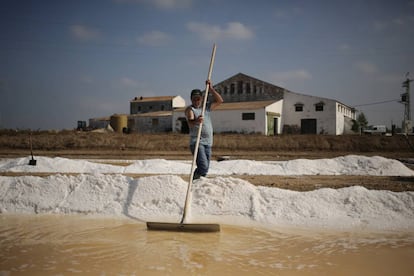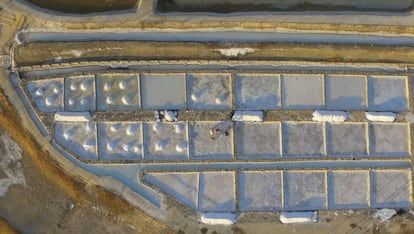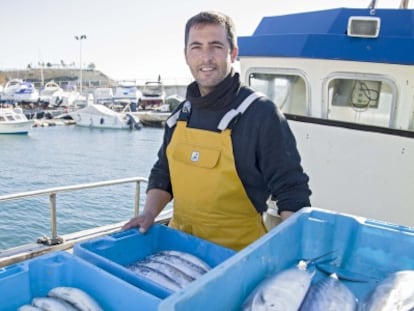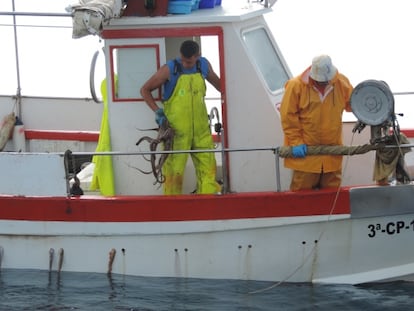Spain’s disappearing reserves of white gold
Once a global salt producer, Cadiz has only five artisan salt flats left

Like his grandfather and father before him, Demetrio Berenguer, 54, was born in a salt marsh and has spent his working life practicing the ancient craft of salt harvesting, his face tanned by years under the harsh sun of southern Andalusia. He says he could turn his hand to something else, but is holding out for a revival of this dying trade, which has witnessed the closure of 166 salterns out of 171 in the area.
With this in mind, Berenguer is working with Cadiz University and NGO Salarte, the latter set up to save the area’s salterns. Watched by researchers, Berenguer shovels mounds of salt into the main aisle of the La Esperanza saltern in Puerto Real. As he does so, he explains the process using an antiquated vocabulary peppered with words that some of those present struggle to understand.
According to Gonzalo Muñoz, a lecturer at Cadiz University and technical coordinator of La Esperanza, which the university bought for research in the 1980s: “It’s not just about preserving the trade, it’s also about maintaining the culture and the biodiversity associated with it.”
Salterns like La Esperanza can produce between 1,000 and 3,000 tons of salt a year
La Esperanza is one of the five salterns that have survived in this area, along with Bartivás in Chiclana, San Vicente in San Fernando, El Águila in Puerto Real and the inland saltern of Iptuci in the Alcornocales Natural Park. “Cadiz was once the biggest and best producer of salt in the world,” says Muñoz. “Boats came from all over to buy salt from here.”
“It’s a crying shame,” says Juan Martín, President of Salarte. “We would prefer it if we didn’t have to exist but we need to prove that the traditional salterns are still viable today.”
In Bartivás, fourth-generation salt harvesters offer a degree of hope. Pilar Ruiz is one of the four siblings who run it, though all have other jobs to balance the books. In summer, they extract normal table salt and high quality salt such as fine hand-harvested sea salt and salt flakes, amounting to between 2,500 and 3,000 tons, which they will sell during the year.
Chemical-free salt
Unlike industrial salt, there is no chemical process involved. They don’t need to wash it or iodize it as machines are not involved. “The only concession to modernization is to use a dumper truck outside to help with the extraction,” says Pilar Ruiz.
The result is salt with far less sodium chloride, according to Martín.

But despite the obvious benefits of traditionally harvested salt, industrial salt is so much cheaper to produce, which means there is little demand for the former. “If this were an industrial plant, it would employ two people instead of six,” says Ruiz. “The salt culture has been lost because people just want what’s cheapest.”
With a 25kg bag selling for €3.80, there isn’t much money in it for the family. An additional problem has been legislation introduced in recent years to protect Spain’s coastline, which has meant long court battles to keep the salt marshes and their property in the family. “This land has been in the family since 1903 and now it seems it’s not. It’s considered a concession so we can’t mortgage any of it if we need financing for the business,” explains Pilar.
In the middle of Los Alcornocales Natural Park, José Antonio García, 31, the owner of the Roman saltern of Iptuci, is also feeling the squeeze. But despite the difficulties entailed in maintaining the business, he won’t hear about going industrial. “The most modern implement I have here is a hand cart,” he says. The source of his salt, unlike those on the coast, is a saltwater spring. “I would have to close if it dried up,” he says. “Otherwise I will keep on fighting to keep this alive, because it’s my life.”
Biodiversity
Among the most important in Spain, these salterns continue to function according to an old and labyrinthine system that favors biodiversity. The salt marshes and swamps feed a variety of crustaceans, fish and birds, including flamencos whose pink color comes from feeding on the saltwater shrimp. “In this case, human intervention actually improves the salt marshes,” says Martín whose team is convinced of the importance of maintaining hand-harvested salt for the biodiversity of the area. Along with Salarte, they have launched a project to support business cooperatives that can brand the salt and sell it more profitably, like the French company, Guérande.
“If the product is diversified, the business becomes more sustainable,” says Javier Benavente, the director general of Cadiz University’s research team, mentioning birdwatching and cultural tourism as spinoffs.
It’s not just about preserving the trade, it’s also about maintaining the culture and the biodiversity associated with it
Meanwhile, Martín continues to make his case for the preservation of this dying trade. “Salterns like La Esperanza can produce between 1,000 and 3,000 tons of salt a year,” he says. “This would generate €500,000 and give work to eight or 10 people.”
This is a scenario he hopes can be repeated in 40 or 50 of Cadiz’s abandoned salterns.
In the meantime, Cadiz University is putting La Esperanza out to tender. Berenguer prays that it will find a buyer and give him his job back. In return, he promises to share everything he knows about the near-extinct artisan salt business.
English version by Heather Galloway.
Tu suscripción se está usando en otro dispositivo
¿Quieres añadir otro usuario a tu suscripción?
Si continúas leyendo en este dispositivo, no se podrá leer en el otro.
FlechaTu suscripción se está usando en otro dispositivo y solo puedes acceder a EL PAÍS desde un dispositivo a la vez.
Si quieres compartir tu cuenta, cambia tu suscripción a la modalidad Premium, así podrás añadir otro usuario. Cada uno accederá con su propia cuenta de email, lo que os permitirá personalizar vuestra experiencia en EL PAÍS.
¿Tienes una suscripción de empresa? Accede aquí para contratar más cuentas.
En el caso de no saber quién está usando tu cuenta, te recomendamos cambiar tu contraseña aquí.
Si decides continuar compartiendo tu cuenta, este mensaje se mostrará en tu dispositivo y en el de la otra persona que está usando tu cuenta de forma indefinida, afectando a tu experiencia de lectura. Puedes consultar aquí los términos y condiciones de la suscripción digital.











































